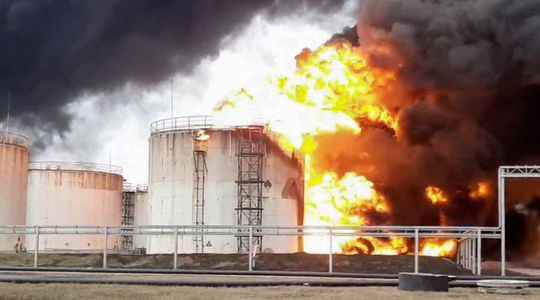Mysterious incidents dot Russia. Since the beginning of April, military or paramilitary sites have been the target of “industrial disasters”, “fires” and other accidents. Sunday, May 1, Moscow recognized for the first time an act of “sabotage” committed on its territory. The incident in question: part of a railway line used for freight collapsed at a bridge, without causing any casualties, north of Belgorod, 35 km from the Ukrainian border. In the process, the Investigative Committee, the main investigative agency of the Russian state, opened a criminal investigation into what it described as a “terrorist act”, according to the Associated Press.
Russia has repeatedly accused Ukrainian forces of having carried out strikes on its soil, in regions close to the border with Ukraine. Although they are frequent in Russia, it is difficult to speak of simple industrial accidents. And for good reason: the sites of the disasters are all of crucial interest to the Russian armies. In early April, the governor of the Belgorod region claimed that Ukrainian MI 24 attack helicopters had raided and hit a fuel depot. For its part, Ukraine has not admitted being behind the attack. “The doubt that the Ukrainians are behind this accident remains minimal”, indicates Emmanuel Dupuy, president of the Institute Prospective and Security in Europe.
On April 27, an arms depot located in a Russian village near the border with Ukraine caught fire. “According to preliminary information, an ammunition depot is on fire near the village of Staraya Nelidovka” about twenty kilometers from the Ukrainian border, said at the time, on Telegram, the governor of the Russian region of Belgorod, Vyacheslav Gladkov.
“The Battle for Supplies”
Two days before, a fire had ravaged a fuel depot in the heart of the Briansk region, also neighboring Ukraine, further weakening Russian logistics. The same day, the military analyst Rob Lee declared to the British daily The Guardian footage suggested the fire was “probably” caused by Ukrainian sabotage: “It looks like something was flying through the air before the explosion. I think it was probably a Ukrainian attack, but we can’t say be certain.”
Faced with this series of incidents, the Tageszeitung, a German daily published in Berlin, declares: “It cannot be a coincidence or a simple technical accident.” For their part, the Ukrainian authorities have offered no clear explanation, leaving some doubts. Mikhailo Podolyak, adviser to the Ukrainian presidency, quipped on April 27 that the fires and explosions produced in Russia would be a form of “demilitarization”, one of the conditions that the Kremlin demands of kyiv for peace.
However, the Ukrainians’ objective would be to weaken the Russians’ logistics line according to Emmanuel Dupuy: “These explosions have a strategic importance, because they delay the reinforcement of Russian military capacities in the Donbass while allowing the Ukrainians to compensate for the report of force, which is quantitatively at the expense of the Ukrainian forces (1-3) but the accelerated contribution for three weeks of American and European weapons puts this balance of power into perspective. It should be noted that for the Kremlin’s equipment to transit from the northern front, it must pass through Russian territory.
The specialist believes that Ukraine now assumes that its action must be “multidimensional” in order to act on several fronts at the same time. “There is a supply battle going on,” notes the expert. Moreover, this series of incidents occurs in a context of “counter-offensive” on the part of Ukraine, which is said to be in the process of retaking a certain number of villages. “The Ukrainians are in the process of pushing the Russian device and limiting the nibbling capacity that the Russians wanted to put in place”, resumes Emmanuel Dupuy.
Sites far from the border also affected
While many of the affected military sites are within Ukraine’s border regions, there are a few exceptions. Monday, May 2, it is the turn of the Perm powder and explosives complex, located in the Urals, to explode: it provided fuel for Russian missiles and rockets. The accident caused the death of two people. Ten days earlier, a fire had ravaged a military research institute in Tver, 160 km from Moscow. The death toll had been established at 17, according to regional authorities.
By striking on Russian territories, Ukraine launches into a race with its adversary. “They know the Russians are playing against time, they need a victory to declare by the military parade on May 9 – the day the Kremlin celebrates the victory over Nazi Germany in 1945 – hence the importance for the Ukrainians to delay this deadline”, analyzes Emmanuel Dupuy. For its part, the Russian Federal Security Service (FSB) announces each week the dismantling of terrorist cells.
At the same time, the conflict seems to spill over into Moldova, a country in Eastern Europe. President Maia Sandu convened her national security council on Tuesday (April 26) after a series of explosions in the pro-Russian separatist region of Transnistria. According to Emmanuel Dupuy, “the Russian objective is to open several fronts so that the Ukrainian troops are not totally dedicated to that of Donbass.”
